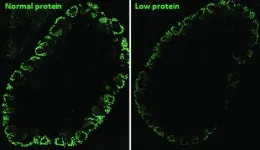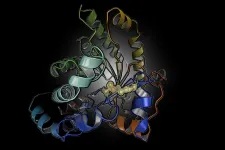(Press-News.org) Leather is an ever growing multi-billion dollar industry requiring more than 3.8 billion bovine animals - equal to one for every two people on earth - to sustain production each year. And while the products - clothing, shoes, furniture and more - can be quite elegant and durable, the environmental impact of leather production has been severe, leading to deforestation, water and land overuse, environmental pollution, and greenhouse gas emissions.
Researchers at Tufts University School of Engineering set out to find an alternative to leather, with similar texture, flexibility and stiffness, yet focused on materials that are sustainable, non-toxic, and friendly to the environment. It turns out, we have been wearing that material all along - it's silk, but instead of weaving the silk into fabric, the Tufts engineers were able to break down the fibers from silkworm cocoons into their protein components, and re-purpose the proteins to form the leather-like material. The process for making silk-based leather is described in a study published in the journal Materials & Design.
The silk-based leather can be printed into different patterns and textures, has similar physical properties to real leather, and can withstand the folding, piercing, and stretching typically used to create leather goods, including the ability to stitch together pieces of material and attach hardware such as rivets, grommets, handles and clasps.
"Our work is centered on the use of naturally-derived materials that minimize the use of toxic chemicals while maintaining material performance so as to provide alternatives for products that are commonly and widely used today," said Fiorenzo Omenetto, Frank C. Doble Professor of Engineering at Tufts School of Engineering, director of the Tufts Silklab where the material was created, and corresponding author of the study. "By using silk, as well as cellulose from textile and agricultural waste and chitosan from shell-fish waste, and all the relatively gentle chemistries used to combine them, we are making progress towards this goal."
There is of course already an existing portfolio of alternative leathers developed by industry and the research community, with a focus on using agricultural byproducts or regenerated materials that have a reduced impact on the environment and animal raising. These include leather-like materials made from petroleum (polyurethane leather or "pleather"), tree bark, pineapple husks, plant oils, rubber, fungi, and even from cellulose and collagen produced by bacterial cultures.
The silk-based leather made at Tufts offers some unique advantages to all of these approaches. In addition to being derived from dissolving silk fibers, manufacturing is water based, using only mild chemicals, conducted at room temperature, and producing mostly non-toxic waste. The silk leather material can be fabricated using computerized 3D layering with the ability to create regular micropatterns that can tune the material's strength and flexibility, print macropatterns for aesthetics (e.g. a basket weave) as well as non-regular geometrical patterning to mimic the surface texture of real leather. The resulting materials, like leather, are strong, soft, pliable, and durable, and like natural leather, they are biodegradable once they enter the waste stream.
In fact, the silk-leather products could be re-dissolved and regenerated into its gel-like stock matter to be re-printed into new products
The process of making the silk leather starts with silk fibers that are commonly used in the textile industry. These fibers are made up of silk fibroin protein polymers, and they can be broken down to its individual protein components in a water-based slurry. A base layer of chitosan containing a non-toxic plasticizer glycerol and dye is printed by extrusion through a tiny bore nozzle onto a surface to provide flexibility and strength to the material. Chitosan is itself derived from natural sources such as the shells of crabs lobsters and shrimp. A layer of silk fibroin combined with plasticizer and a thickener (from vegetable gum) is printed on top of the base layer.
Extruding the fibroin slurry through the printer nozzle creates shear forces that may contribute to arranging the proteins in a way that that strengthens the material, making it ductile rather than brittle, and mimics the natural extrusion that occurs in the silk gland of a worm or spider. Changing the printed pattern of the silk layer can provide a range of appearance, tunable strengths and other physical qualities.
The printing method, also referred to as "additive manufacturing" is known to be very conservative in the use of materials and waste produced compared to other methods like injection molding or subtractive manufacturing (like carving or shaving from a block).
The Silklab at Tufts has developed a wide range of other products from silk, from implantable medical devices to architectural materials that can sense and respond to the environment by changing color. In fact, much of the technology that has been developed in the lab to derivatize the silk proteins can be applied to the silk-based leather, including attaching and embedding molecules that can sense and respond to the surrounding environment.
"That's the advantage of using silk protein over other methods - it has a well-established, versatile chemistry which we can use to tune the qualities of the material and embed smart elements like sensing molecules," said Laia Mogas-Soldevila, former research fellow in the Silklab, currently assistant professor of Architecture at University of Pennsylvania Stuart Weitzman School of Design and first author of the study. "So while there may be many options for leather-like materials, silk-based leather has the potential to be most amenable to innovative designs."
INFORMATION:
PITTSBURGH, May 5, 2021 - Subtle differences in the shape of the brain that are present in adolescence are associated with the development of psychosis, according to an international team led by neuroscientists at the University of Pittsburgh School of Medicine and Maastricht University in the Netherlands.
In results published today in JAMA Psychiatry, the differences are too subtle to detect in an individual or use for diagnostic purposes. But the findings could contribute to ongoing efforts to develop a cumulative risk score for psychosis that would allow for earlier detection and treatment, as well as targeted therapies. The discovery was made with the largest-ever ...
Besides being underweight, babies born to women whose diet lacked sufficient protein during pregnancy tend to have kidney problems resulting from alterations that occurred while their organs were forming during the embryonic stage of their development.
In a study published in PLOS ONE, researchers affiliated with the University of Campinas (UNICAMP) in the state of São Paulo, Brazil, discovered the cause of the problem at the molecular level and its link to epigenetic phenomena (changes in gene expression due to environmental factors such as stress, exposure to toxins or malnutrition, among others).
According to the authors, between 10% and 13% of the world population ...
Researchers from the University of Liverpool have shown the potential of repurposing an existing and cheap drug into a long-acting injectable therapy that could be used to treat Covid-19.
In a paper published in the journal Nanoscale, researchers from the University's Centre of Excellence for Long-acting Therapeutics (CELT) demonstrate the nanoparticle formulation of niclosamide, a highly insoluble drug compound, as a scalable long-acting injectable antiviral candidate.
The team started repurposing and reformulating identified drug compounds with the potential for COVID-19 therapy candidates within weeks of the first lockdown. Niclosamide is just one of the drug compounds identified and has been shown to be highly effective against SARS-CoV-2 in a number of laboratory studies.
Using ...
New Johns Hopkins University simulations offer an intriguing look into Saturn's interior, suggesting that a thick layer of helium rain influences the planet's magnetic field.
The models, published this week in AGU Advances, also indicate that Saturn's interior may feature higher temperatures at the equatorial region, with lower temperatures at the high latitudes at the top of the helium rain layer.
It is notoriously difficult to study the interior structures of large gaseous planets, and the findings advance the effort to map Saturn's hidden regions.
"By ...
The incorporation of boron into polycyclic aromatic hydrocarbon systems leads to interesting chromophoric and fluorescing materials for optoelectronics, including organic light-emitting diodes (OLEDS) and field-effect transistors, as well as polymer-based sensors. In the journal Angewandte Chemie, a research team has now introduced a new anionic organoborane compound. Synthesis of the borafluorene succeeded through the use of carbenes.
Borafluorene is a particularly interesting boron-containing building block. It is a system of three carbon rings joined at the edges: two six-membered and one central five-membered ring, whose free tip is the boron atom. While neutral, radical, and cationic (positively ...
Proteins perform a vast array of functions in the cell of every living organism with critical roles in almost every biological process. Not only do they run our metabolism, manage cellular signaling and are in charge of energy production, as antibodies they are also the frontline workers of our immune system fighting human pathogens like the coronavirus. In view of these important duties, it is not surprising that the activity of proteins is tightly controlled. There are numerous chemical switches that control the structure and, therefore, the function of proteins in response to changing environmental conditions and stress. ...
Philadelphia, May 5, 2021--When Luke Terrio was about seven months old, his mother began to realize something was off. He had constant ear infections, developed red spots on his face, and was tired all the time. His development stagnated, and the antibiotics given to treat his frequent infections stopped working. His primary care doctor at Children's Hospital of Philadelphia (CHOP) ordered a series of blood tests and quickly realized something was wrong: Luke had no antibodies.
At first, the CHOP specialists treating Luke thought he might have X-linked agammaglobulinemia (XLA), a rare immunodeficiency syndrome seen in children. However, as the CHOP research team continued investigating Luke's case, they realized Luke's condition was unlike any disease described ...
Pesticides have been used in European agriculture for more than 70 years, so monitoring their presence, levels and their effects in European soils quality and services is needed to establish protocols for the use and the approval of new plant protection products.
In an attempt to deal with this issue, a team led by the prof. Dr. Violette Geissen from Wageningen University (Netherlands) have analysed 340 soil samples originating from three European countries to compare the contentdistribution of pesticide cocktails in soils under organic farming practices and soils under conventional practices. This study was a combined effort of 3 EC funded projects addressing soil
quality: RECARE (http://www.recare-project.eu/), iSQAPER (http://www.isqaper-project.eu) ...
T-cells play a central role in our immune system: by means of their so-called T-cell receptors (TCR) they make out dangerous invaders or cancer cells in the body and then trigger an immune reaction. On a molecular level, this recognition process is still not sufficiently understood.
Intriguing observations have now been made by an interdisciplinary Viennese team of immunologists, biochemists and biophysicists. In a joint project funded by the Vienna Science and Technology Fund and the FWF, they investigated which mechanical processes take place when an antigen is recognized: ...
Larger bumblebees are more likely to go out foraging in the low light of dawn, new research shows.
University of Exeter scientists used RFID - similar technology to contactless card payments - to monitor when bumblebees of different sizes left and returned to their nest.
The biggest bees, and some of the most experienced foragers (measured by number of trips out), were the most likely to leave in low light.
Bumblebee vision is poor in low light, so flying at dawn or dusk raises the risk of getting lost or being eaten by a predator.
However, the bees benefit from extra foraging time and fewer competitors for pollen in the early morning.
"Larger bumblebees have bigger eyes than their smaller-sized nest mates and many other bees, and can therefore see better in dim light," said lead author ...




